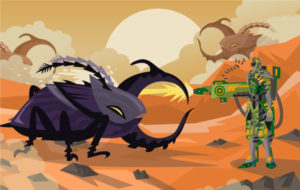GO-DEVILS AND HELGRAMITES
As early as my sixth year of life I had begun noticing that some kind of bug was dominant every summer. And what showed up as dominant differed each year—the same bug never got the honors twice in a row. One summer it was grasshoppers. I’d never seen so many grasshoppers, they were simply everywhere—hopping, eating, doing grasshopper things. When I walked a field they sprang from my approach in their vast numbers like the parting of a grasshopper Red Sea. I heard local farmers complain about their destructive appetites.
Next year it was something else, then something else. I especially remember the year of the helgramites, for I was terrorized all summer. Most people have everything to learn about the well-named helgramite, so let me explain. In typical insect fashion, this unique bug has two phases in its life cycle and both phases can be disconcerting if you’re just a little kid.
Its larval phase appears as a fat, segmented, centipede-like sort of crusty brown thingy about two inches long that lives in a state of savagery beneath rocks in shallow flowing streams—a lurking, inherently criminal sort of existence. At this stage only scientists call them by their right name, which I forget. They are called go-devils by fishermen who collect them in tin cans to be used as a choice sort of bait. Go-devils are thought to be delectable to bluegills and red-gilled sun perch (also called “redeye” in the loosey-goosey way fishermen name fish), according to experienced fishermen who know anything at all.
The important thing to know about go-devils is that they sport ice tongs on both ends.
Now if you’re a typical ill-informed modern who doesn’t know what old fashioned ice tongs look like, go straightaway and google a picture because that’s the only way you’re going to appreciate go-devils. The tongs on the front end can grow to an inch or more long—two big curvy needle-pointed appendages that can open wide and chomp down on your unwary finger, scissor-like, hard enough to draw blood. The tongs on the rear end are not as big but can still be alarming while you’re trying to get the squirming thing onto a fishhook. With my own eyes—this is a true story—I saw my friend Willie pull a redeye from Joe Smith’s big pond and, when he went to unhook it, found not that the fish had swallowed the go-devil, rather the go-devil had pinioned the fish with its front tongs through the fish’s lip. The bait caught the fish. That’s the devilish thing’s larval stage.
The mature adult helgramite is worse. It’s a monstrously oversized fly of a thing that can grow to six inches or more in length—and it still has those ice tongs on the front end, bigger than ever. They too can draw blood from the unwary finger. I remember my abject horror the day I went to open the coal house door…and laid my hand squarely on a helgramite sitting there sunning itself on the door handle. Some people call them Dobson flies, but I know better. Helgramites are the insect from hell.
